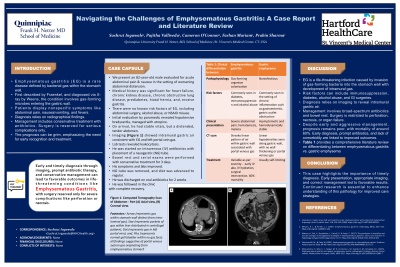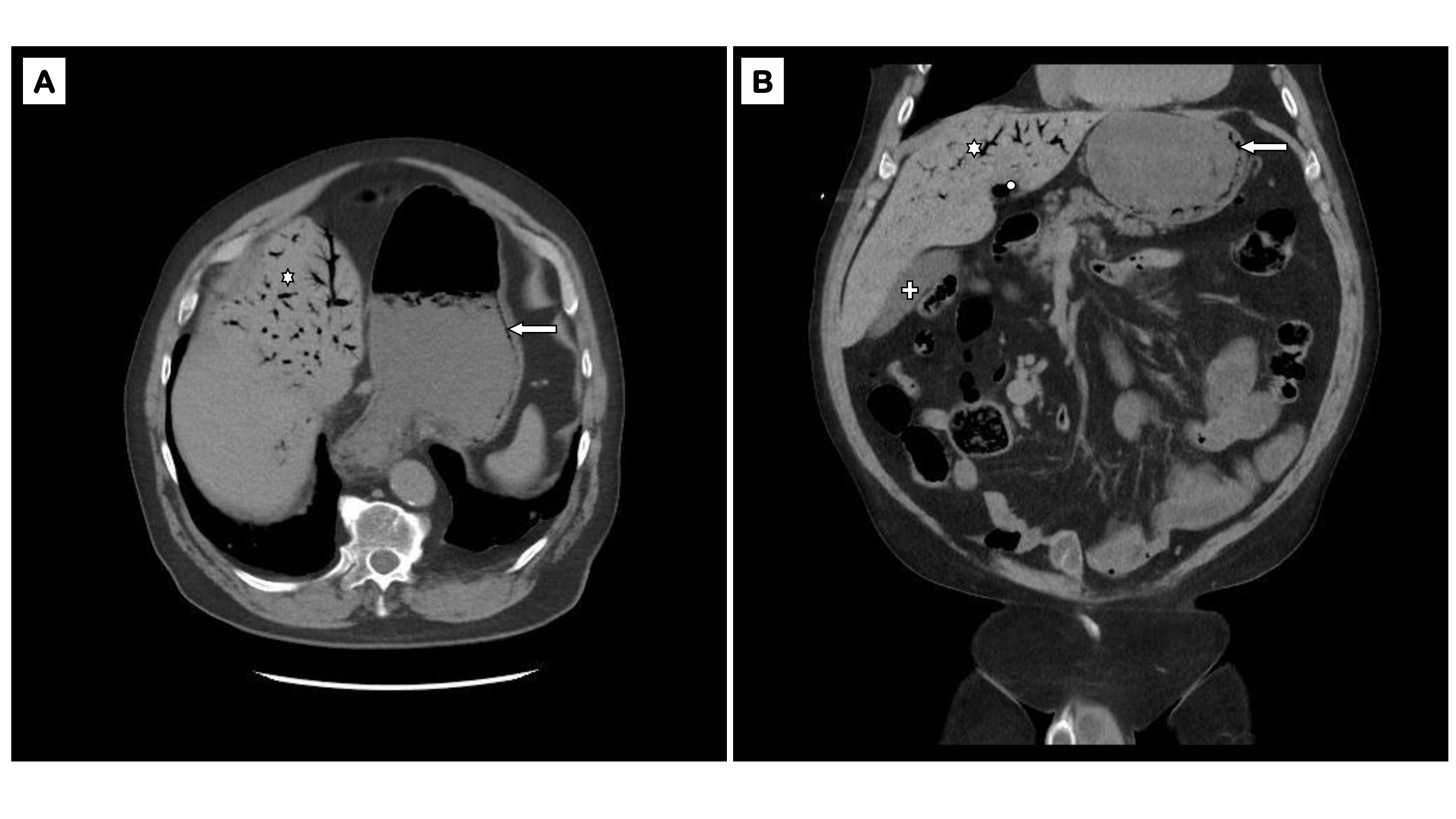Sunday Poster Session
Category: Stomach
P1702 - Navigating the Challenges of Emphysematous Gastritis: A Case Report and Literature Review
Sunday, October 27, 2024
3:30 PM - 7:00 PM ET
Location: Exhibit Hall E

Has Audio

Sushrut Ingawale, MD, MBBS
Quinnipiac University Frank H. Netter MD School of Medicine / St. Vincent's Medical Center
Bridgeport, CT
Presenting Author(s)
Sushrut Ingawale, MD, MBBS1, Pujitha Vallivedu Chennakesavulu, MD, MBBS1, Cameron E.. O'Connor, BS2, Mariam Farhan, MD1, Prabin Sharma, MD1
1Quinnipiac University Frank H. Netter MD School of Medicine / St. Vincent's Medical Center, Bridgeport, CT; 2Quinnipiac University Frank H. Netter MD School of Medicine / St. Vincent's Medical Center, North Haven, CT
Introduction: Emphysematous gastritis (EG) is a rare disease defined by bacterial gas within the stomach wall. First described by Fraenkel, and diagnosed via X-ray by Weens, the condition involves gas-forming microbes entering the gastric wall. Patients display nonspecific symptoms like abdominal pain, nausea/vomiting, and fevers. Diagnosis relies on radiographical findings. Management includes conservative treatment with antibiotics. Surgery is reserved for serious complications only. The prognosis can be grim, emphasizing the need for early recognition and treatment.
Case Description/Methods: We present an 82-year-old male evaluated for acute abdominal pain & nausea in the setting of worsening abdominal distension. Medical history was significant for heart failure, chronic kidney disease, chronic obstructive lung disease, prediabetes, hiatal hernia, and, erosive gastritis. There were no known risk factors of EG, including abdominal surgery, alcohol abuse, or NSAID misuse. Initial evaluation by paramedic revealed hypotensive bradycardia, managed with atropine. On arrival, he had stable vitals, but a distended, tender abdomen. Imaging (Figure) showed intramural gastric air consistent with EG and left portal vein gas. Lab tests revealed leukocytosis. He was started on intravenous (IV) antibiotics with placement of a nasogastric (NG) tube. Bowel rest and serial exams were performed with conservative treatment for 3 days. His symptoms and labs improved. NG tube was removed, and diet was advanced to regular. The patient was discharged on oral antibiotics for 2 weeks and followed in the clinic with complete recovery.
Discussion: EG is a life-threatening infection caused by invasion of gas-forming bacteria into the stomach wall with development of intramural gas. Risk factors can include immunosuppression, diabetes, alcohol abuse, and GI surgeries. Diagnosis relies on imaging to reveal intramural gastric air. Management involves broad-spectrum antibiotics and bowel rest. Surgery is restricted to perforation, necrosis, or organ failure. Despite early and aggressive management, prognosis remains poor, with mortality of around 60%. Early diagnosis, prompt antibiotics, and lack of comorbidity are linked to improved outcomes. This case highlights the importance of timely diagnosis. Early presentation, appropriate imaging, and correct management led to favorable results. Continued research is essential to enhance understanding of this pathology for improved care strategies.

Disclosures:
Sushrut Ingawale, MD, MBBS1, Pujitha Vallivedu Chennakesavulu, MD, MBBS1, Cameron E.. O'Connor, BS2, Mariam Farhan, MD1, Prabin Sharma, MD1. P1702 - Navigating the Challenges of Emphysematous Gastritis: A Case Report and Literature Review, ACG 2024 Annual Scientific Meeting Abstracts. Philadelphia, PA: American College of Gastroenterology.
1Quinnipiac University Frank H. Netter MD School of Medicine / St. Vincent's Medical Center, Bridgeport, CT; 2Quinnipiac University Frank H. Netter MD School of Medicine / St. Vincent's Medical Center, North Haven, CT
Introduction: Emphysematous gastritis (EG) is a rare disease defined by bacterial gas within the stomach wall. First described by Fraenkel, and diagnosed via X-ray by Weens, the condition involves gas-forming microbes entering the gastric wall. Patients display nonspecific symptoms like abdominal pain, nausea/vomiting, and fevers. Diagnosis relies on radiographical findings. Management includes conservative treatment with antibiotics. Surgery is reserved for serious complications only. The prognosis can be grim, emphasizing the need for early recognition and treatment.
Case Description/Methods: We present an 82-year-old male evaluated for acute abdominal pain & nausea in the setting of worsening abdominal distension. Medical history was significant for heart failure, chronic kidney disease, chronic obstructive lung disease, prediabetes, hiatal hernia, and, erosive gastritis. There were no known risk factors of EG, including abdominal surgery, alcohol abuse, or NSAID misuse. Initial evaluation by paramedic revealed hypotensive bradycardia, managed with atropine. On arrival, he had stable vitals, but a distended, tender abdomen. Imaging (Figure) showed intramural gastric air consistent with EG and left portal vein gas. Lab tests revealed leukocytosis. He was started on intravenous (IV) antibiotics with placement of a nasogastric (NG) tube. Bowel rest and serial exams were performed with conservative treatment for 3 days. His symptoms and labs improved. NG tube was removed, and diet was advanced to regular. The patient was discharged on oral antibiotics for 2 weeks and followed in the clinic with complete recovery.
Discussion: EG is a life-threatening infection caused by invasion of gas-forming bacteria into the stomach wall with development of intramural gas. Risk factors can include immunosuppression, diabetes, alcohol abuse, and GI surgeries. Diagnosis relies on imaging to reveal intramural gastric air. Management involves broad-spectrum antibiotics and bowel rest. Surgery is restricted to perforation, necrosis, or organ failure. Despite early and aggressive management, prognosis remains poor, with mortality of around 60%. Early diagnosis, prompt antibiotics, and lack of comorbidity are linked to improved outcomes. This case highlights the importance of timely diagnosis. Early presentation, appropriate imaging, and correct management led to favorable results. Continued research is essential to enhance understanding of this pathology for improved care strategies.

Figure: Figure: Computed Tomography Scan of Abdomen - Part (A) Axial view, (B) Coronal view.
Footnotes:- Arrow (represents gas within stomach wall distinct from intra-luminal gas), Star (represents pockets of gas within liver distributed in centrifugal pattern), Dot (represents gas in left portal vein), and, Plus (represents normal gall bladder within no gas foci); all findings suggestive of portal venous system gas originating from emphysematous stomach
Footnotes:- Arrow (represents gas within stomach wall distinct from intra-luminal gas), Star (represents pockets of gas within liver distributed in centrifugal pattern), Dot (represents gas in left portal vein), and, Plus (represents normal gall bladder within no gas foci); all findings suggestive of portal venous system gas originating from emphysematous stomach
Disclosures:
Sushrut Ingawale indicated no relevant financial relationships.
Pujitha Vallivedu Chennakesavulu indicated no relevant financial relationships.
Cameron O'Connor indicated no relevant financial relationships.
Mariam Farhan indicated no relevant financial relationships.
Prabin Sharma indicated no relevant financial relationships.
Sushrut Ingawale, MD, MBBS1, Pujitha Vallivedu Chennakesavulu, MD, MBBS1, Cameron E.. O'Connor, BS2, Mariam Farhan, MD1, Prabin Sharma, MD1. P1702 - Navigating the Challenges of Emphysematous Gastritis: A Case Report and Literature Review, ACG 2024 Annual Scientific Meeting Abstracts. Philadelphia, PA: American College of Gastroenterology.
